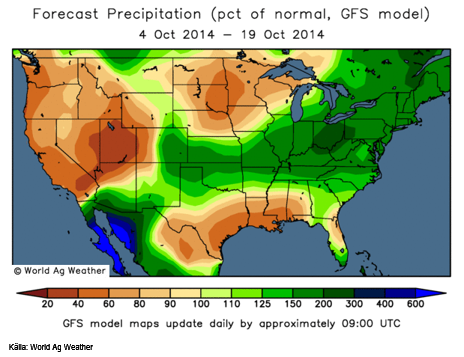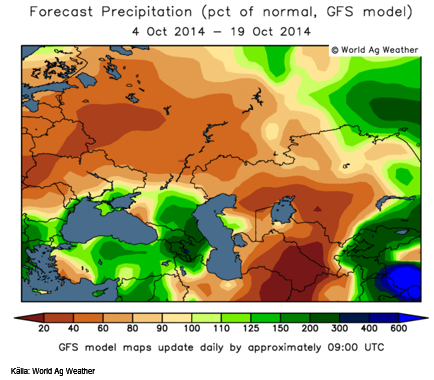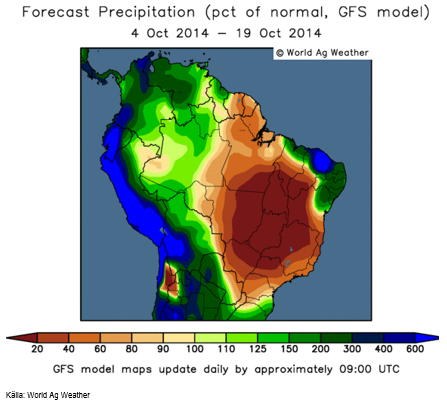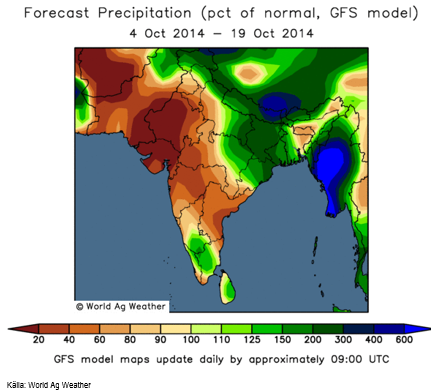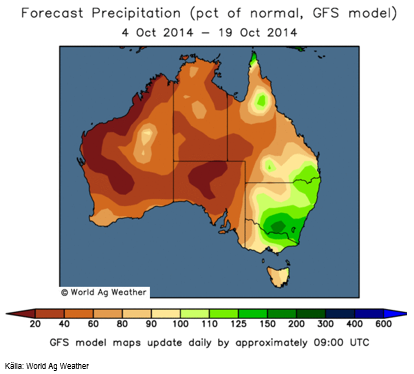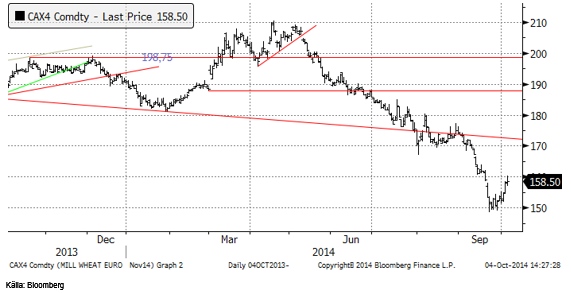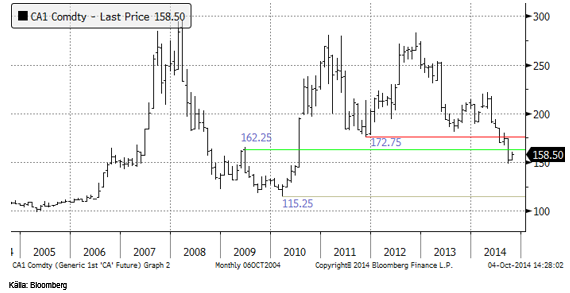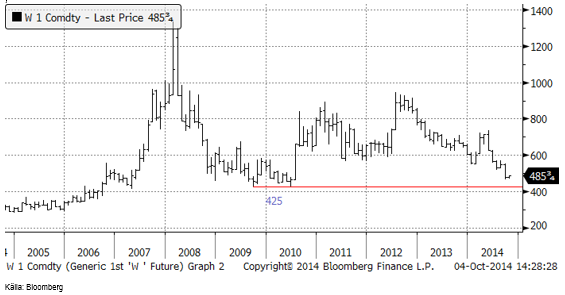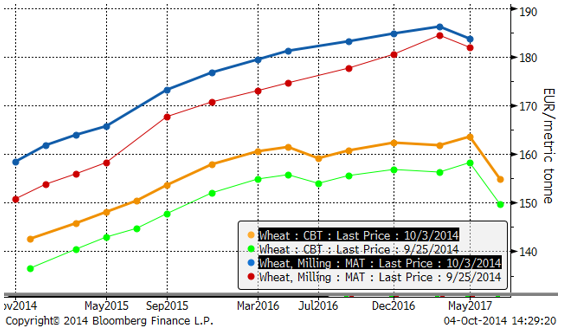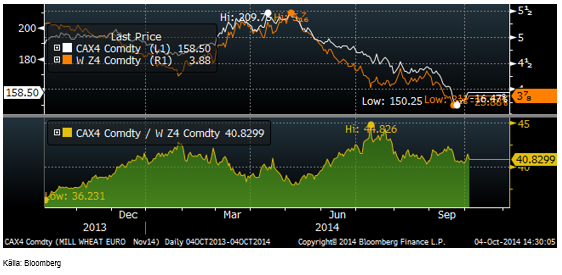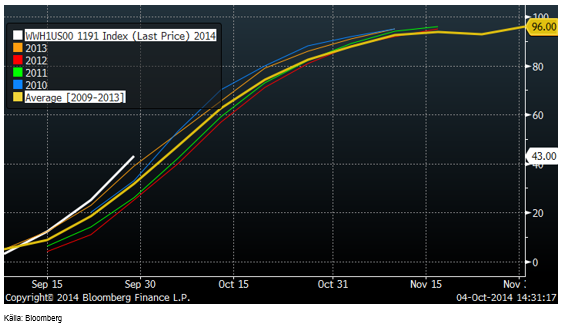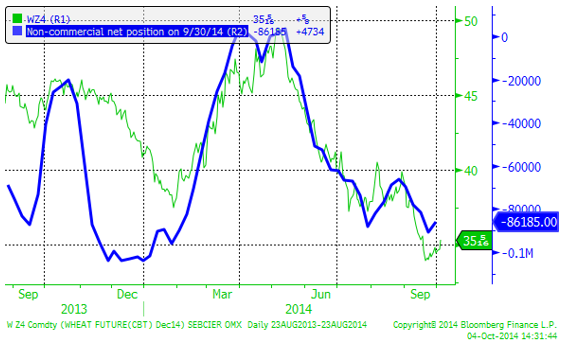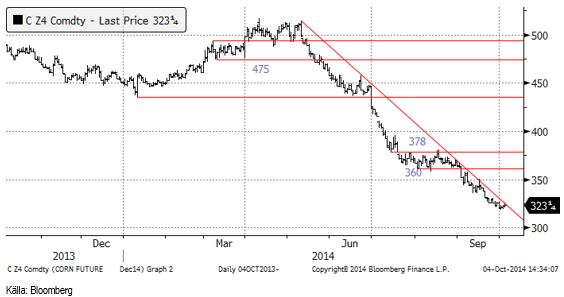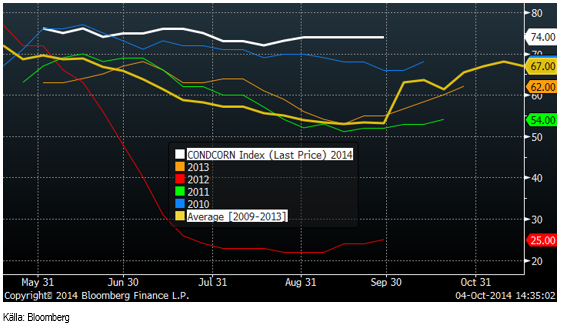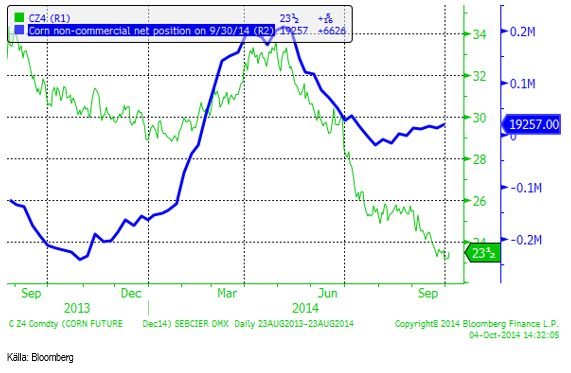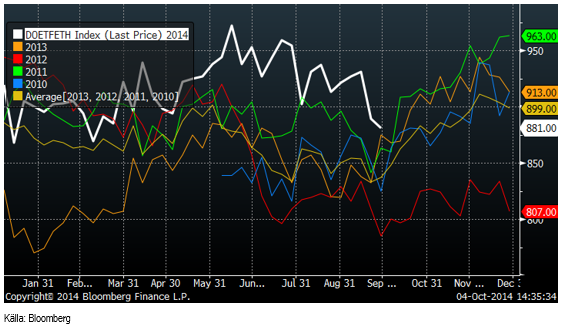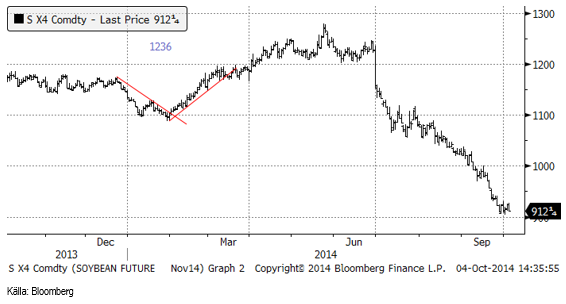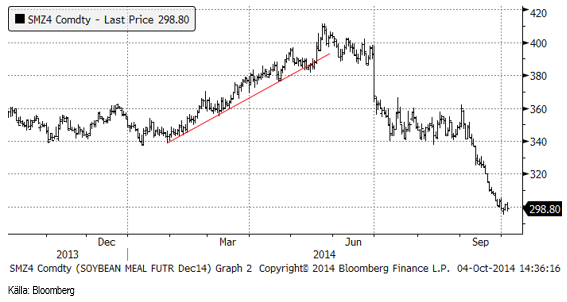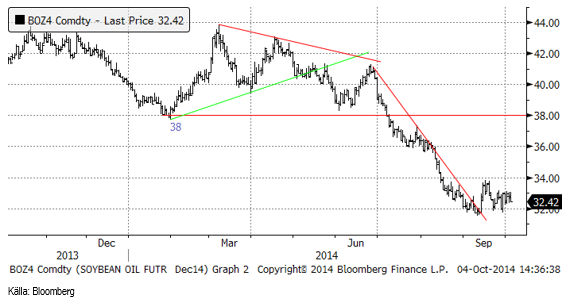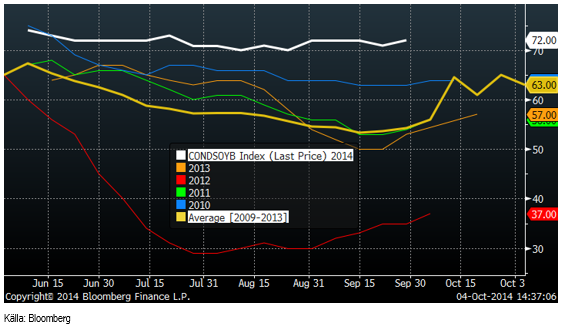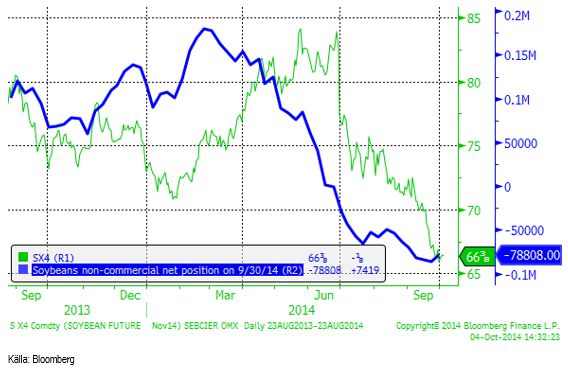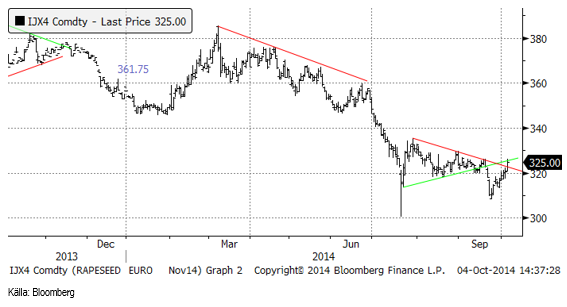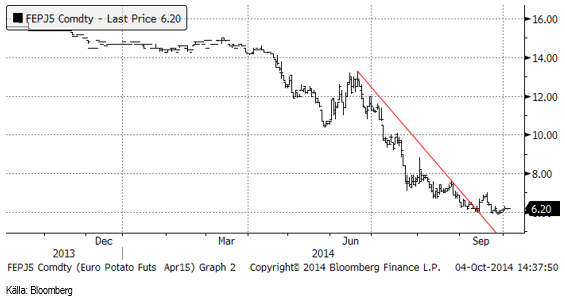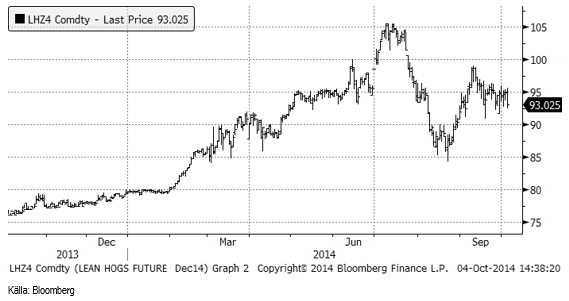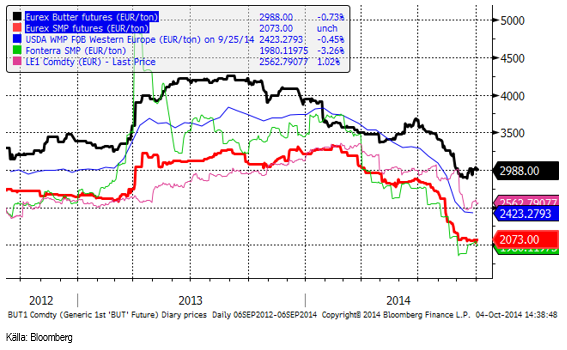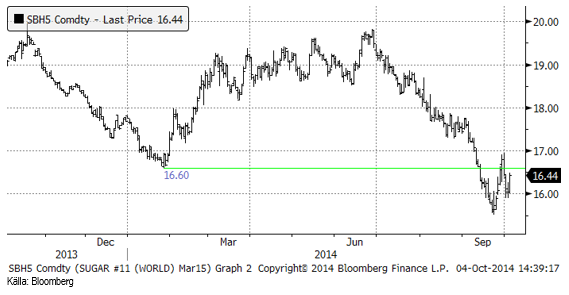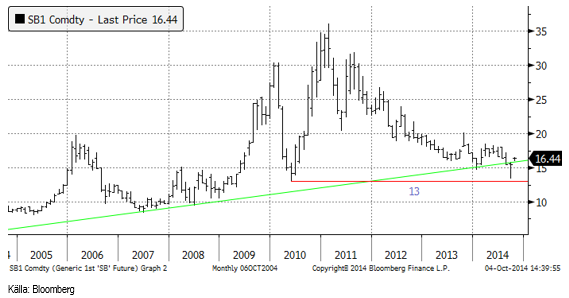Analys
SEB Jordbruksprodukter, 6 oktober 2014


 Priserna på jordbruksprodukter har fallit mycket, mer än de flesta andra råvaror i år. Nu börjar prisfallen bli mindre och det finns tecken på trendbrott i flera av dem. Ett trendbrott innebär i sig inte att en ny trend uppåt etableras omedelbart, men det värsta är över och risk / reward är större på uppsidan än nedsidan.
Priserna på jordbruksprodukter har fallit mycket, mer än de flesta andra råvaror i år. Nu börjar prisfallen bli mindre och det finns tecken på trendbrott i flera av dem. Ett trendbrott innebär i sig inte att en ny trend uppåt etableras omedelbart, men det värsta är över och risk / reward är större på uppsidan än nedsidan.
Torkan i Brasilien, som är skrämmande intensiv är en trendförändrare. Den gör att skörden av sojabönor och majs omöjligen kan bli så stor som tidiga prognoser indikerat.
Odlingsväder
Som vi ser väntas västra Europa få upp till dubbla den normala nederbörden de kommande två veckorna. Det väntas regna över Skanderna, vilket fyller på vattenmagasinen inför vintern, vilket påverkar elpriset i Norden. Det är samtidigt väldigt torrt i östra Europa.
Prognoskartan för nederbörden i USA visar torrt väder i ’corn belt’ och blötare typiska veteodlingsområden som Kansas och Oklaholma.
Ryssland, Ukraina, Vitryssland, och överhuvud taget alla länder kring Svarta havet väntas på 40-60% av normal nederbörd de kommande två veckorna.
I Brasilien ser väderleksprognosen förskräckande torr ut. Stora och viktiga odlingsområden väntas få mindre än 20% av normal nederbörd de kommande två veckorna. Detta är en rejäl trendförändrare för soja, majs, socker och kanske kaffe.
Indiens monsun fortsätter att vara mindre intensiv än normalt.
Australien väntas få mindre nederbörd än förväntat, utom just i SW, där odlingen av vete huvudsakligen sker.
Vete
Vetepriset (novmeberterminen på Matif) har tagit sig upp från 150 euro nästan till 160. Där finns dock ett starkt motstånd och ur teknisk synvinkel skulle man kunna tänka sig en rekyl nedåt. Detta är dock ändå förmodligen en så låg nivå att det skulle kunna handla om de lägsta nivåerna för den här säsongen.
I nedanstående diagram ser vi hur Matifs ”spotkontrakt” utvecklat sig de senaste tio åren. Priset är på en nivå som tidigare varit bottennivåer. Därmed ska man inte utgå från att priset vänder upp från den här nivån genast. Tidigare har priset stannat på en låg nivå i flera månader, innan det vänt upp igen.
Chicagovetet (december) har en liten bit kvar på nedsidan innan marknaden rör vid ett starkt stöd.
Nedan ser vi terminskurvorna i fredags och en vecka tidigare för Matif respektive Chicago. Det är contango på båda marknader.
Matifs novemberkontrakt håller sig i samma relation som tidigare till Chicagos decemberkontrakt.
Sådden av höstvete har nått 43% färdigt. Det är den snabbaste takten de senaste åren och nästan 10% snabbare än genomsnittet för de senaste åren.
I den senaste GASC-tendern tog Frankrike hem allt, men till riktigt låga priser. Amerikanskt vete offererades inte alls.
StatsCanada visar på en skörd (preliminär) på 27.5 mt, 26.8 mt lägre än förra året. Det var i stort sett i linje med förväntningarna.
Non-commercials i CFTC:s rapport verkar ha passerat den mest korta positionen. I den senaste rapporten hade de köpt tillbaka en del av den korta positionen.
Det börjar utveckla sig till köpläge i vete. Det finns antagligen utrymme för en liten nedgång på kort sikt, men på längre sikt finns en klar uppsidespotential.
Majs
Decemberkontraktet CZ4, ligger som i ser i kursdiagrammet nedan, precis under motståndslinjen för den fallande pristrenden. Motståndet är ännu inte brutet, men det kan mycket väl ske den här veckan. Det markerar i så fall slutet på den fallande pristrenden. Det är inte detsamma som att en stigande pristrend tar vid, men ofta är det början på en uppgång.
Crop condition låg oförändrat på höga 74% good/excellent i måndags.
Non-commercials köpte ytterligare några kontrakt i veckan.
DOE rapporterade i veckan som gick att etanolproduktionen i USA sjönk igen, som vi ser i diagrammet nedan. Hösten är en säsongsmässigt svag period och produktionen kommer säkerligen att ta mer fart från mitten av oktober.
Vi vänder alltså till köprekommendation.
Sojabönor
Sojabönorna (SX4) har under september fallit från 1000 cent ner till 912. Det verkar som om det finns stöd för priset vid 900. Bryts det, finns nästa stöd vid 800 cent.
Sojamjölet föll, som förutspåddes för två veckor sedan, ner till 300 dollar. Det kan mycket väl vara slutet på nedgångsfasen.
Sojaoljan har fallit i pris med ungefär 25% sedan i våras (för ny skörd). Den fallande pristrenden bröts för en månad sedan och sedan des har priset stabiliserat sig strax över 32 dollar och med ett tak på 34 dollar. Prisfallet lär ha kylt av all expansion av palmoljeoldling och därmed kan en rekyl uppåt i priset på vegetabilisk olja motiveras. För sojaolja är det i så fall till 36 eller kanske 38 dollar. På dessa nivåer finns starka motstånd, där 38 dollar är det starkare av de två.
Crop condition för sojabönor steg återigen upp till 72% good / excellent.
Non-commmercials nettosålda position verkar inte vilja bli mer såld än vad den är. Den senaste veckan köpte spekulanterna tillbaka 7400 kontrakt och är nu nettosålda 78,808 kontrakt.
Jag tror att såväl sojaolja som sojamjöl och därmed sojabönor kan ha funnit en botten och går därmed över till köprekommendation.
Raps
Novemberkontraktet för rapsfrö som ”skulle” ha rekylerat ner igen, gick rakt igenom tekniskt motstånd, upp till 325 euro i fredags. Det är samma höga nivå som priset hade innan det föll kraftigt ner mot 300 euro i september. Priset ”borde” gå ner igen från den här nivån.
Statistics Canada raporterade preliminära skördeestimat i veckan som gick. För canola estimerades en skörd på 14.08 mt, vilket är 21.6% mindre än förra året. Det var i princip i linje med förväntningarna.
Vi fortsätter med säljrekommendation på rapsterminer.
Potatis
Potatispriset har hållit sig över 6 euro den senaste månaden, sedan den fallande pristrenden bröts. Det är ett gott tecken. Priset stängde på 6.20 euro. Marknaden brukar vara svag fram till slutet av oktober och sedan stiga till en topp i december. Om man köper potatis nu, ska man försökta ta sig ur positionen i december allra senast. Därefter är det inte lätt att veta vart priset tar vägen. Potatis har handlats till noll i USA, därför att det kan vara värt att sälja en vara som potatis till noll för att bli av med den.
Skörden i nordvästra Europa går mot sitt slut. Total produktion i NWE ser ut att kunna bli 27 mt, vilket är i nivå med produktionen år 2011 och högre än förra och förrförra året. Hektarskörden ser ut att kunna bli 49 ton per hektar, vilket är 9% högre än förra året. De regn som nu drar in över just NWE kan dock orsaka en del problem för den skörd som är kvar att ta upp.
Gris
Lean hogs decemberkontrakt ligger kvar kring 95 cent per pund där priset legat den senaste månaden.
Mjölk
Terminerna på smör och SMP ligger kvar i princip på den nivå de haft den senaste veckan.
För två veckor sedan var det många som tolkade det då oförändrade priset på Fonterra-auktionen som att ”botten är nådd”. Jag påpekade att det sällan är så och att trenden fortsätter längre än de flesta kan föreställa sig. Den senaste Fonterra-auktionen den första oktober visade 7.3% lägre pris, i genomsnitt.
Smörpriset föll med 6.6% medan SMP backade med mer blygsamma 2.7%. Helmjölkspulver föll med hela 10%. Osten verkar ha sett sin värsta nedgång, med 1.2%.
EU:s stöd för lagring drogs som bekant tillbaka i sin helhet efter att det visat sig att Italienska kooperativ försökt fuska till sig stöd på ett sätt som var så stötande att stödet helt och hållet alltså togs bort.
Terminspriserna är dock så låga på Eurex att det förmodligen är en bra idé att köpa till de nivåerna om man lyckas med det, och absolut avhålla sig från att sälja terminer. En sådan prissäkring skulle bli alldeles för dyr i dagens läge.
Socker
Torkan i Brasilien bör kunna ge stöd för sockerpriset. Tekniskt finns dock motstånd strax över dagens pris på 16.44 cent per pund.
Nedan ser i prisutvecklingen för spotkontraktet de senaste tio åren. Prisfallet tog ner råsockerpriset till 13 cent, som utgjorde bottennoteringen år 2010. Det var en nivå där köpare dök upp och det skedde samtidigt som väderleksprognosen för Brasilien såg allt torrare ut. Det är torrt även i nordvästra Indien, som också är centrum för den indiska sockerrörsodlingen. Indien och Brasilien är världens största producenter av socker.
[box]SEB Veckobrev Jordbruksprodukter är producerat av SEB Commodities Sales desk och publiceras i samarbete och med tillstånd på Råvarumarknaden.se[/box]
Detta marknadsföringsmaterial, framtaget av SEB’s Commodities Sales desk, har upprättats enbart i informationssyfte.
Även om innehållet är baserat på källor som SEB bedömt som tillförlitliga ansvarar SEB inte för fel eller brister i informationen. Den utgör inte oberoende, objektiv investeringsanalys och skyddas därför inte av de bestämmelser som SEB har infört för att förebygga potentiella intressekonflikter. Yttranden från SEB’s Commodities Sales desk kan vara oförenliga med tidigare publicerat material från SEB, då den senare hänvisas uppmanas du att läsa den fullständiga rapporten innan någon åtgärd vidtas.
Dokumentationen utgör inte någon investeringsrådgivning och tillhandahålls till dig utan hänsyn till dina investeringsmål. Du uppmanas att självständigt bedöma och komplettera uppgifterna i denna dokumentation och att basera dina investeringsbeslut på material som bedöms erforderligt. Alla framåtblickande uttalanden, åsikter och förväntningar är föremål för risker, osäkerheter och andra faktorer och kan orsaka att det faktiska resultatet avviker väsentligt från det förväntade. Historisk avkastning är ingen garanti för framtida resultat. Detta dokument utgör inte ett erbjudande att teckna några värdepapper eller andra finansiella instrument. SEB svarar inte för förlust eller skada – direkt eller indirekt, eller av vad slag det vara må – som kan uppkomma till följd av användandet av detta material eller dess innehåll.
Observera att det kan förekomma att SEB, dess ledamöter, dess anställda eller dess moder- och/eller dotterbolag vid olika tillfällen innehar, har innehaft eller kommer att inneha aktier, positioner, rådgivningsuppdrag i samband med corporate finance-transaktioner, investment- eller merchantbankinguppdrag och/eller lån i de bolag/finansiella instrument som nämns i materialet.
Materialet är avsett för mottagaren, all spridning, distribuering mångfaldigande eller annan användning av detta meddelande får inte ske utan SEB:s medgivande. Oaktat detta får SEB tillåta omfördelning av materialet till utvald tredje part i enlighet med gällande avtal. Materialet får inte spridas till fysiska eller juridiska personer som är medborgare eller har hemvist i ett land där sådan spridning är otillåten enligt tillämplig lag eller annan bestämmelse.
Skandinaviska Enskilda Banken AB (publ) är ett [publikt] aktiebolag och står under tillsyn av Finansinspektionen samt de lokala finansiella tillsynsmyndigheter i varje jurisdiktionen där SEB har filial eller dotterbolag.
Analys
Tightening fundamentals – bullish inventories from DOE

The latest weekly report from the US DOE showed a substantial drawdown across key petroleum categories, adding more upside potential to the fundamental picture.

Commercial crude inventories (excl. SPR) fell by 5.8 million barrels, bringing total inventories down to 415.1 million barrels. Now sitting 11% below the five-year seasonal norm and placed in the lowest 2015-2022 range (see picture below).
Product inventories also tightened further last week. Gasoline inventories declined by 2.1 million barrels, with reductions seen in both finished gasoline and blending components. Current gasoline levels are about 3% below the five-year average for this time of year.
Among products, the most notable move came in diesel, where inventories dropped by almost 4.1 million barrels, deepening the deficit to around 20% below seasonal norms – continuing to underscore the persistent supply tightness in diesel markets.
The only area of inventory growth was in propane/propylene, which posted a significant 5.1-million-barrel build and now stands 9% above the five-year average.
Total commercial petroleum inventories (crude plus refined products) declined by 4.2 million barrels on the week, reinforcing the overall tightening of US crude and products.


Analys
Bombs to ”ceasefire” in hours – Brent below $70

A classic case of “buy the rumor, sell the news” played out in oil markets, as Brent crude has dropped sharply – down nearly USD 10 per barrel since yesterday evening – following Iran’s retaliatory strike on a U.S. air base in Qatar. The immediate reaction was: “That was it?” The strike followed a carefully calibrated, non-escalatory playbook, avoiding direct threats to energy infrastructure or disruption of shipping through the Strait of Hormuz – thus calming worst-case fears.

After Monday morning’s sharp spike to USD 81.4 per barrel, triggered by the U.S. bombing of Iranian nuclear facilities, oil prices drifted sideways in anticipation of a potential Iranian response. That response came with advance warning and caused limited physical damage. Early this morning, both the U.S. President and Iranian state media announced a ceasefire, effectively placing a lid on the immediate conflict risk – at least for now.
As a result, Brent crude has now fallen by a total of USD 12 from Monday’s peak, currently trading around USD 69 per barrel.
Looking beyond geopolitics, the market will now shift its focus to the upcoming OPEC+ meeting in early July. Saudi Arabia’s decision to increase output earlier this year – despite falling prices – has drawn renewed attention considering recent developments. Some suggest this was a response to U.S. pressure to offset potential Iranian supply losses.
However, consensus is that the move was driven more by internal OPEC+ dynamics. After years of curbing production to support prices, Riyadh had grown frustrated with quota-busting by several members (notably Kazakhstan). With Saudi Arabia cutting up to 2 million barrels per day – roughly 2% of global supply – returns were diminishing, and the risk of losing market share was rising. The production increase is widely seen as an effort to reassert leadership and restore discipline within the group.
That said, the FT recently stated that, the Saudis remain wary of past missteps. In 2018, Riyadh ramped up output at Trump’s request ahead of Iran sanctions, only to see prices collapse when the U.S. granted broad waivers – triggering oversupply. Officials have reportedly made it clear they don’t intend to repeat that mistake.
The recent visit by President Trump to Saudi Arabia, which included agreements on AI, defense, and nuclear cooperation, suggests a broader strategic alignment. This has fueled speculation about a quiet “pump-for-politics” deal behind recent production moves.
Looking ahead, oil prices have now retraced the entire rally sparked by the June 13 Israel–Iran escalation. This retreat provides more political and policy space for both the U.S. and Saudi Arabia. Specifically, it makes it easier for Riyadh to scale back its three recent production hikes of 411,000 barrels each, potentially returning to more moderate increases of 137,000 barrels for August and September.
In short: with no major loss of Iranian supply to the market, OPEC+ – led by Saudi Arabia – no longer needs to compensate for a disruption that hasn’t materialized, especially not to please the U.S. at the cost of its own market strategy. As the Saudis themselves have signaled, they are unlikely to repeat previous mistakes.
Conclusion: With Brent now in the high USD 60s, buying oil looks fundamentally justified. The geopolitical premium has deflated, but tensions between Israel and Iran remain unresolved – and the risk of missteps and renewed escalation still lingers. In fact, even this morning, reports have emerged of renewed missile fire despite the declared “truce.” The path forward may be calmer – but it is far from stable.
Analys
A muted price reaction. Market looks relaxed, but it is still on edge waiting for what Iran will do

Brent crossed the 80-line this morning but quickly fell back assigning limited probability for Iran choosing to close the Strait of Hormuz. Brent traded in a range of USD 70.56 – 79.04/b last week as the market fluctuated between ”Iran wants a deal” and ”US is about to attack Iran”. At the end of the week though, Donald Trump managed to convince markets (and probably also Iran) that he would make a decision within two weeks. I.e. no imminent attack. Previously when when he has talked about ”making a decision within two weeks” he has often ended up doing nothing in the end. The oil market relaxed as a result and the week ended at USD 77.01/b which is just USD 6/b above the year to date average of USD 71/b.

Brent jumped to USD 81.4/b this morning, the highest since mid-January, but then quickly fell back to a current price of USD 78.2/b which is only up 1.5% versus the close on Friday. As such the market is pricing a fairly low probability that Iran will actually close the Strait of Hormuz. Probably because it will hurt Iranian oil exports as well as the global oil market.
It was however all smoke and mirrors. Deception. The US attacked Iran on Saturday. The attack involved 125 warplanes, submarines and surface warships and 14 bunker buster bombs were dropped on Iranian nuclear sites including Fordow, Natanz and Isfahan. In response the Iranian Parliament voted in support of closing the Strait of Hormuz where some 17 mb of crude and products is transported to the global market every day plus significant volumes of LNG. This is however merely an advise to the Supreme leader Ayatollah Ali Khamenei and the Supreme National Security Council which sits with the final and actual decision.
No supply of oil is lost yet. It is about the risk of Iran closing the Strait of Hormuz or not. So far not a single drop of oil supply has been lost to the global market. The price at the moment is all about the assessed risk of loss of supply. Will Iran choose to choke of the Strait of Hormuz or not? That is the big question. It would be painful for US consumers, for Donald Trump’s voter base, for the global economy but also for Iran and its population which relies on oil exports and income from selling oil out of that Strait as well. As such it is not a no-brainer choice for Iran to close the Strait for oil exports. And looking at the il price this morning it is clear that the oil market doesn’t assign a very high probability of it happening. It is however probably well within the capability of Iran to close the Strait off with rockets, mines, air-drones and possibly sea-drones. Just look at how Ukraine has been able to control and damage the Russian Black Sea fleet.
What to do about the highly enriched uranium which has gone missing? While the US and Israel can celebrate their destruction of Iranian nuclear facilities they are also scratching their heads over what to do with the lost Iranian nuclear material. Iran had 408 kg of highly enriched uranium (IAEA). Almost weapons grade. Enough for some 10 nuclear warheads. It seems to have been transported out of Fordow before the attack this weekend.
The market is still on edge. USD 80-something/b seems sensible while we wait. The oil market reaction to this weekend’s events is very muted so far. The market is still on edge awaiting what Iran will do. Because Iran will do something. But what and when? An oil price of 80-something seems like a sensible level until something do happen.
-

 Nyheter3 veckor sedan
Nyheter3 veckor sedanMahvie Minerals växlar spår – satsar fullt ut på guld
-

 Nyheter4 veckor sedan
Nyheter4 veckor sedanUppgången i oljepriset planade ut under helgen
-

 Nyheter4 veckor sedan
Nyheter4 veckor sedanLåga elpriser i sommar – men mellersta Sverige får en ökning
-

 Nyheter3 veckor sedan
Nyheter3 veckor sedanJonas Lindvall är tillbaka med ett nytt oljebolag, Perthro, som ska börsnoteras
-

 Analys3 veckor sedan
Analys3 veckor sedanA muted price reaction. Market looks relaxed, but it is still on edge waiting for what Iran will do
-

 Nyheter3 veckor sedan
Nyheter3 veckor sedanOljan, guldet och marknadens oroande tystnad
-

 Analys4 veckor sedan
Analys4 veckor sedanVery relaxed at USD 75/b. Risk barometer will likely fluctuate to higher levels with Brent into the 80ies or higher coming 2-3 weeks
-

 Nyheter3 veckor sedan
Nyheter3 veckor sedanDomstolen ger klartecken till Lappland Guldprospektering


